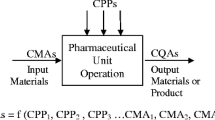Abstract
The partial least square technique (PLS) was applied to the monoclonal antibody (Mab) CB.Hep-1 immunosorbent manufacturing to determine the influence of cyanate ester concentration, ligand concentration and target ligand density on Mab coupling efficiency, elution capacity, Hepatitis B surface antigen purity and ligand leakage (output variables). Results demonstrated that cyanate ester concentration, ligand concentration and density do not have an influence on output variables in assessed ranges. Conversely, the eluted antigen purity was significantly influenced by cyanate ester concentration and ligand concentration. In conclusion, the PLS application allows for the identification of critical variables and improvement of established chromatographic processes.



Similar content being viewed by others
References
Chase HA (1984) Chem Eng Sci 39:1099–1125. doi:10.1016/0009-2509(84)85074-5
Wilcheck M, Miron T (1999) React Funct Polym 41:263–268. doi:10.1016/S1381-5148(99)00042-5
Hardy E, Martínez E, Diago D, Díaz R, González D, Herrera L (2000) J Biotechnol 77:157–167. doi:10.1016/S0168-1656(99)00201-1
Gómez L, Hernández R, Ibarra N, Valdés R, Campos Y, Tamayo A et al (2002) J Biochem Biophys Methods 52:151–159. doi:10.1016/S0165-022X(02)00013-1
Hernández R, Plana L, Gómez L, Expósito N, Valdés J, Páez R et al (2005) J Chromatogr B Analyt Technol Biomed Life Sci 816:1–6. doi:10.1016/j.jchromb.2004.04.020
Gabrielsson J, Lindberg NO, Lundstedt T (2002) J Chemom 16:141–160. doi:10.1002/cem.697
Chiang LH, Leardi R, Pell RJ, Seasholtz MB (2006) Chemom Intell Lab Syst 81:109–119. doi:10.1016/j.chemolab.2005.10.006
Lundstedt-Enkela K, Gabrielsson J, Olsman H, Seifert E, Pettersen J, Lek PM et al (2006) Chemom Intell Lab Syst 84:201–207. doi:10.1016/j.chemolab.2006.05.013
Fontirrochi G, Dueñas M, Fernández de Cossío ME, Fuentes P, Pérez M, Mainet D et al (1993) Biotechnol Apl 10:24–30
Valdés R, Díaz T, Nieto A, García C, Pérez M, García J et al (1995) Biotecnol Apl 12:115–126
Paez R, Agraz A, Herrera L (1992) Acta Biotechnol 13:117–122. doi:10.1002/abio.370130207
Agraz A, Quiñones Y, Expósito N, Breña F, Madruga J, Pentón E et al (1993) Biotechnol Bioeng 42:1238–1244. doi:10.1002/bit.260421014
Lowry OH, Rosenbrough NJ, Farr AL, Randal RJ (1951) J Biol Chem 193:256–275
Valdés R, Leyva JL, González E, Mainet D, Costa L (1994) Biotecnol Apl 11:219–224
Axen R, Porath J, Ernback S (1967) Nature 214:1302–1304. doi:10.1038/2141302a0
Kohn J, Wilchek M (1978) Biochem Biophys Res Commun 84:7–14. doi:10.1016/0006-291X(78)90255-3
Laemmli UK (1970) Nature 227:680–685. doi:10.1038/227680a0
March SC, Parikh I, Cuatrecasas P (1974) Anal Biochem 60:149–152. doi:10.1016/0003-2697(74)90139-0
Subramanian A, Van Cott KE, Milbrath DS, Velander WH (1994) J Chromatogr A 672:11–24. doi:10.1016/0021-9673(94)80590-3
Wold S, Sjöström M, Eriksson L (2001) Chemom Intell Lab Syst 58:109–130. doi:10.1016/S0169-7439(01)00155-1
Nauman EB (2002) Elementary reactions. In: Chemical reactor design, optimization and scale-up. McGraw Hill, USA, pp 4–10
Kohn W, Wilcheck M (1982) Enzyme Microb Technol 4:161–163. doi:10.1016/0141-0229(82)90109-0
Acknowledgments
Authors kindly thank the Center for Genetic Engineering and Biotechnology for the financial support of this work. The first author gratefully acknowledges Relma Tavares de Oliveira, for the inspiration for writing this paper. The team of authors is grateful to Rebecca Deming Ballentine for her assistance in polishing the manuscript.
Author information
Authors and Affiliations
Corresponding author
Rights and permissions
About this article
Cite this article
Fernández, E.G., Valdés, R., Montero, J.A. et al. Application of the Partial Least Square Technique to Identify Critical Variables in the Immunosorbent Manufacturing. Chroma 68, 375–380 (2008). https://doi.org/10.1365/s10337-008-0689-0
Received:
Revised:
Accepted:
Published:
Issue Date:
DOI: https://doi.org/10.1365/s10337-008-0689-0




